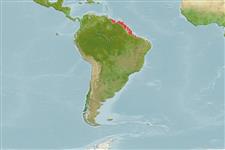Klassifizierung / Names
Namen | Synonyme | Catalog of Fishes(Gattung, Arten) | ITIS | CoL | WoRMS | Cloffa
Environment: milieu / climate zone / depth range / distribution range
Ökologie
seewasser; brackwasser demersal; tiefenbereich 15 - 20 m (Ref. 86589). Tropical; 9°N - 7°S, 60°W - 34°W
Western Atlantic: Coastal rivers from Guyana to northern Brazil.
Length at first maturity / Size / Gewicht / Alter
Maturity: Lm 52.5, range 46 - 59 cm
Max length : 190 cm TL Männchen/unbestimmt; (Ref. 86589); common length : 90.0 cm TL Männchen/unbestimmt; (Ref. 86589); max. veröff. Gewicht: 50.0 kg (Ref. 5217); max. veröff. Alter: 4 Jahre (Ref. 51994)
Rückenflossenstacheln (insgesamt): 1; Rückenflossenweichstrahlen (insgesamt): 7; Afterflossenweichstrahlen: 18 - 20; Wirbelzahl: 49 - 51. This species is distinguished by the following characters: in life, yellowish body; swim bladder divided into 3 chambers; shield-shaped nuchal plate, usually larger than the supraoccipital process; head shield exposed and granulated in orbital and postorbital regions; first 2 gill with no mesial gill rakers. Sciades parkeri can further be distinguished from sympatric congeners by the following: fleshy furrow connecting posterior nares absent (vs. present in S. couma, S. herzbergii and S. passany); moderately sized posterior chamber of swim bladder (vs. small in S. proops; absent in S. couma, S. herzbergii, S. passany); nuchal plate with no anterior notch (vs. anterior notched in S. proops, sometimes notched in S. herzbergii); palatal patches forming a U-shaped band (vs. transverse in S. passany, lateral edge on accessory patches not emarginated or shallowly notched; lateral edge with an angled and pronounced notch in S. proops) (Ref. 86589).
Mainly found in turbid waters over muddy bottoms in coastal areas, estuaries and lower parts of rivers. Sexually mature after around two years of age. Upon hatching, the alevins are relatively large, approximately 6.0-6.5 cm (Ref. 35381). Marketed fresh and salted (Ref. 5217). Fish exported to Canada, USA, England, and Holland (Rayman Bedessee, pers. comm.).
Distinct pairing. May employ mouth booding as parenting strategy (Ref. 205).
Betancur-R., R.: Marceniuk, A.P. and P. Béarez, 2008. Taxonomic status and redescription of the gillbacker sea catfish (Siluriformes: Ariidae: Sciades parkeri). Copeia 2008(4):827-834. (Ref. 86589)
IUCN Rote Liste Status (Ref. 130435)
Bedrohung für Menschen
Traumatogenic (Ref. 58010)
Nutzung durch Menschen
Fischereien: weniger kommerziell
Mehr Information
ReferenzenAquakulturAquakultur ProfilZuchtlinienGenetikElectrophoresesVererbbarkeitKrankheitenVerarbeitungNutrientsMass conversion
PartnerBilderStamps, Coins Misc.LauteCiguateraGeschwindigkeitSchwimmstilKiemenoberflächeOtolithsGehirngrößeSehfähigkeit
Tools
Zusatzinformationen
Download XML
Internet Quellen
Estimates based on models
Preferred temperature (Ref.
123201): 27.3 - 28.3, mean 27.7 °C (based on 174 cells).
Phylogenetic diversity index (Ref.
82804): PD
50 = 0.5039 [Uniqueness, from 0.5 = low to 2.0 = high].
Bayesian length-weight: a=0.00871 (0.00500 - 0.01517), b=3.10 (2.95 - 3.25), in cm total length, based on LWR estimates for this species & (Sub)family-body (Ref.
93245).
Trophic level (Ref.
69278): 4.1 ±0.6 se; based on diet studies.
Widerstandsfähigkeit (Ref.
120179): hoch, Verdopplung der Population dauert weniger als 15 Monate. (K=0.46; tm=2; tmax=4).
Prior r = 0.76, 95% CL = 0.48 - 1.20, Based on 1 stock assessment.
Fishing Vulnerability (Ref.
59153): Very high vulnerability (90 of 100).
Nutrients (Ref.
124155): Calcium = 63.8 [33.6, 136.7] mg/100g; Iron = 1.04 [0.63, 1.87] mg/100g; Protein = 17.8 [16.1, 19.6] %; Omega3 = 0.215 [0.116, 0.403] g/100g; Selenium = 61.9 [29.2, 143.4] μg/100g; VitaminA = 11.7 [4.2, 32.3] μg/100g; Zinc = 0.723 [0.467, 1.124] mg/100g (wet weight);
